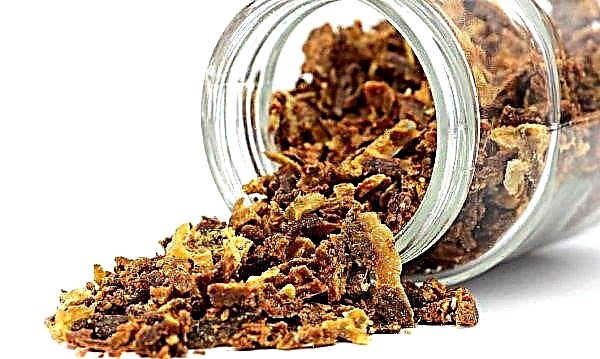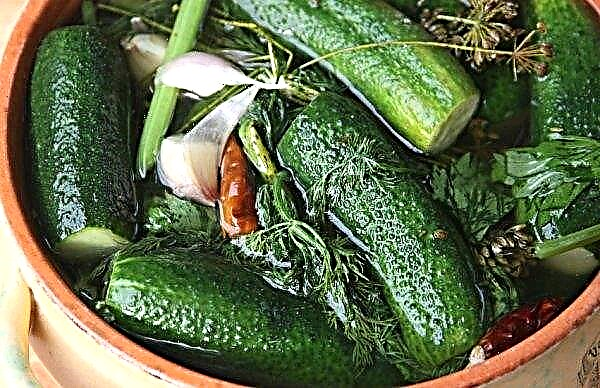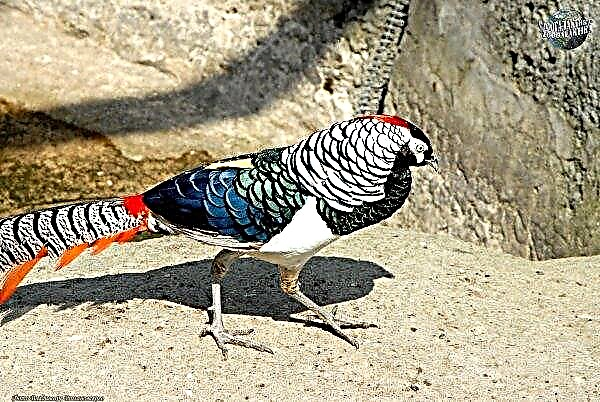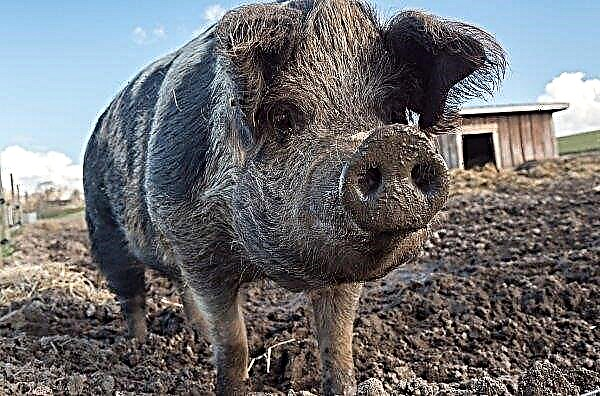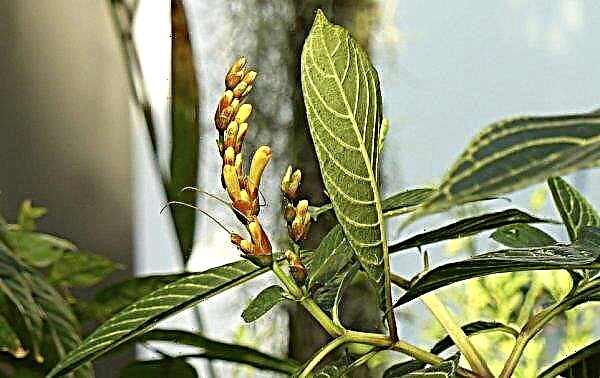Among the modern varieties of tomatoes, "Pink Elephant" is one of the first places in size and taste. By following the care recommendations, you can get an excellent tomato crop on the site.
Grade description
The variety is semi-determinant and reaches 1.5 m in height. Ripening period 110–115 days (medium early). Its external signs are as follows:
- large flattened fruits, closer to the peduncle have a characteristic ribbing;
- the skin is dense, dark pink in color, without interspersing;
- the weight of one tomato is from 300 to 1000 g;
- the pulp is juicy and fleshy, with a small amount of seeds;
- the taste is rich, sweet, without acid;
- a potato leaf of medium size and dark green in color.

Advantages and disadvantages
- Tomato "Pink Elephant" has the following advantages:
- large size of the fetus;
- great taste;
- high productivity;
- transportability and long-term storage;
- resistance to the main types of diseases and pests.
- The variety has its drawbacks:
- the need for the formation of a bush, pinching and garter;
- sensitivity to care (watering, temperature conditions, top dressing);
- not suitable for conservation in general.
Self-growing seedlings
Seedlings are grown in the traditional way and do not require special manipulations. To get seedlings of the selected variety, you need to buy seeds from a trusted supplier or collect yourself.
Optimum timing for sowing
Sowing time depends on the region of residence: in the northern regions it is not recommended to sow seeds before March. Early sowing requires the use of additional lighting.
On average, the beginning of March in the southern regions and the middle of the first month of spring in the northern will be the optimal sowing date.Important! The period from sowing to planting in open ground is approximately 60–65 days.
The soil
For growing seedlings, you can buy a ready-made mixture in the garden center. You can prepare a suitable mixture yourself. For a tomato, the optimal substrate would be:
- one part of garden land;
- one part of peat and humus;
- part of the rotted sawdust;
- add 1.5 cups of ash, 3 tbsp. to a bucket of the finished mixture l superphosphate, 1 tbsp. potassium sulfate, 1 part urea.

Garden land should not contain clay. You must also select all the roots and stones. Pathogens and larvae can be contained in the ground, therefore it is necessary to take measures for disinfection:
- freeze the bag with the ground on the street at a temperature of –15 ° C for several days, then thaw for 3-5 days in the heat and set it again in the cold. Repeat 2-3 times;
- calcine the soil in the oven at +70 ... + 90 ° C for half an hour;
- steam the earth for 7-8 minutes, cool;
- etch with watering a solution of potassium permanganate.
Capacity for growing
For sowing tomato, you can use ready-made containers, peat or plastic. Tanks with a transparent lid are convenient in that they immediately create the greenhouse effect necessary for the emergence of seedlings. If there is no lid, it is necessary to pick up a sheet of glass or a film of sufficient size for the container.

Seeds can also be sown in homemade containers: cardboard boxes or plastic cups from drinks and dairy products. Previously, they need to make several drainage holes.
Seed preparation
Presowing seed treatment includes:
- preliminary rejection in appearance when damaged specimens are removed;
- checking for germination by soaking in a weak solution of potassium permanganate, while "sunken" seeds are selected for sowing;
- soaking in growth stimulants "Kornevin", "Zircon" and "Epin-extra" according to the instructions, for 10-12 hours.
Soaking in potassium permanganate also disinfects the seeds.
Sowing seeds
The seeds of the “Pink Elephant” are sown at a distance of 2.5–3 cm. The distance between the rows is 3-4 cm. The depth of the hole should be 1.5–2 cm.
Sprinkle the seed with soil and immediately pour it with warm water. For the first watering, be sure to use a small stream of sprayer so as not to deepen the seeds. Lastly, the container is covered, leaving an air gap.Did you know? The best germination is demonstrated by seeds aged 2-3 years.

Before emergence, the container is provided with heat and dryness, the optimum temperature is +18 ... + 20 ° С. In the first days, the lid is not removed, then the soil is sprayed as it dries. The average time for the appearance of sprouts is 7–10 days.
Seedling Care
After germination, the seedlings are subjected to a temperature drop to +15 ... + 16 ° C for a week, then returned to room conditions.
Requirements for the favorable development of seedlings:
- spray irrigation without waterlogging;
- ventilation and condensate removal;
- sufficient lighting, reduced watering with a lack of light.
Video: Caring for tomato seedlings
After a dive, moderate watering is maintained. If the plants change color or are very elongated, fertilizing is carried out.
Seedling hardening
Hardening will provide quick adaptation of seedlings to open ground or a greenhouse. A week before the landing, the glasses are taken out for half an hour, gradually increasing the time.
For hardening, a place with diffused light is chosen to avoid leaf burns, and without drafts. Every day increase the amount of sunlight. Before planting, seedlings should spend full daylight hours outdoors.Important! The temperature for tomato seedlings should not fall below +8 ° C!
Hardening can be carried out in a greenhouse, then during the day it is necessary to keep the doors open. At home, you can take the container to the open balcony. If windows are installed there, they must be opened, and first protect the curtains from direct sunlight.
Planting seedlings in a permanent place
It is impossible to indicate the exact time of transplanting seedlings in open ground, because weather conditions are variable. It is necessary to avoid repeated frosts. Such conditions usually occur in mid-May (depending on the region). It is recommended that you have a film in stock to cover the seedlings in the event of a sharp drop in temperature. You can plant seedlings in a heated greenhouse earlier, for example, in April.

The frequency of planting of the "Pink Elephant" should not exceed 2-3 seedlings per m². Leaving a row spacing of 50 cm, the gaps between such bushes will be about 40–45 cm. The planted seedling is watered with warm water.
Features of outdoor cultivation
The tomato "Pink Elephant" allows you to achieve a high yield in the open field. In order to get large and tasty tomatoes, it is necessary to accurately withstand the varietal agricultural technology.
To taste the fruit was sweeter, dissolve the ash in a bucket (1 cup per 10 liters of water) and 1 tbsp. salt and poured half a liter under each bush.Did you know? An optimal balance of humidity and avoiding stagnation of water can be achieved using the drip irrigation system.
Watering
The variety requires abundant frequent watering, up to 2-3 times a week. Up to 10 liters of water are consumed per adult bush. It is recommended to use standing water, which is heated in summer air to a comfortable temperature.

Top dressing
In total, the plant will need 3-4 dressings, one of which should coincide with the period of ovary. Before flowering, nitrogen fertilizers are applied, after fruit set, superphosphate and magnesium sulfate are used according to the instructions.
For proponents of organic farming, the following recipe is suitable:
- make a glass of ash with a liter of boiling water;
- withstand infusion for two days;
- strain the mixture and dilute slightly with water.
Stepson
Varieties of this type need constant pinching. The removal of sprouts must be carried out as early as possible, not exceeding the size of the stepsons of 2.5 cm.
The bush of the "Pink Elephant" is usually formed into one stem. Pinch the growth point after the formation of the leaf above the fourth brush. If the plant is grown in two stems, 2-3 brushes are left on each of them and pinch the growth point above the leaf of the brush located above all.
Video: How and why to plant tomatoes
Soil care
After watering, loosening is carried out if there is bare earth under the plant.
Bushes can be mulched, providing plants:
- protection against overheating and drying of the soil;
- weed protection;
- protection against pollution and, therefore, certain diseases;
- accelerated fruit ripening and increased yield.
Important! Pine bark, freshly cut grass, and materials such as newspapers and cardboard cannot be used to mulch tomatoes.
You can use modern covering materials, for example, a special spanbond, which allows air and moisture to pass through. Planting tomatoes in this case is immediately carried out on a spread sheet in the cut holes.
Sprouted weeds on a bed with tomatoes must be cleaned immediately. Using mulch significantly reduces the number of weeds, and you can fight them without the use of herbicides.
Bush tying
Bush growth requires reliable support. For the first time there will be enough stakes, but it is more convenient to use a trellis stretched over the pipes. It is optimal to stretch 3-4 rows at different heights.

Inspecting the bushes and finding an overloaded branch, it is tied with a soft rope or special industrial materials. Plain wire is too stiff and can damage the stem.
Preventative treatment
To prevent the disease, it is necessary to adhere to such conditions:
- preliminary disinfection of the site with a solution of potassium permanganate;
- mulching, weed removal and timely top dressing;
- watering under the root with warm water without waterlogging.
Reducing the likelihood of late blight will help spraying with copper preparations or iodine solutions. Planting herbs, marigold and marigolds can scare away harmful insects.
Harvesting
Gather ripe tomatoes with pink flesh. Tomatoes are ideal for salads and cooking various dishes. The juice has an unusual pink color and excellent taste characteristics. The fruits have a long shelf life due to the dense skin.

Variety "Pink Elephant" has an excellent taste and very large fruits, but requires careful care. Suitable for lovers of pink tomatoes and collectors, as well as for home gardens and small farms.


